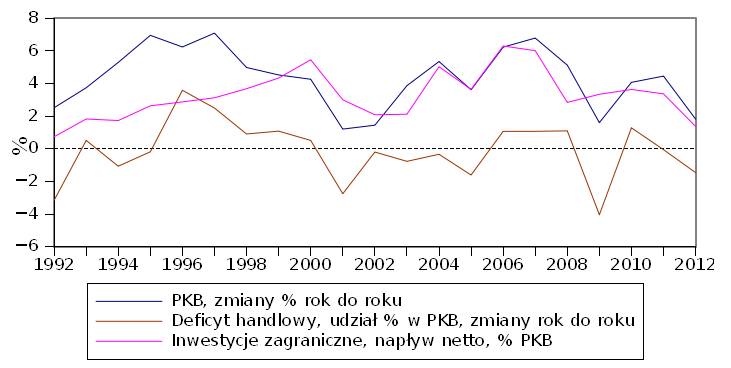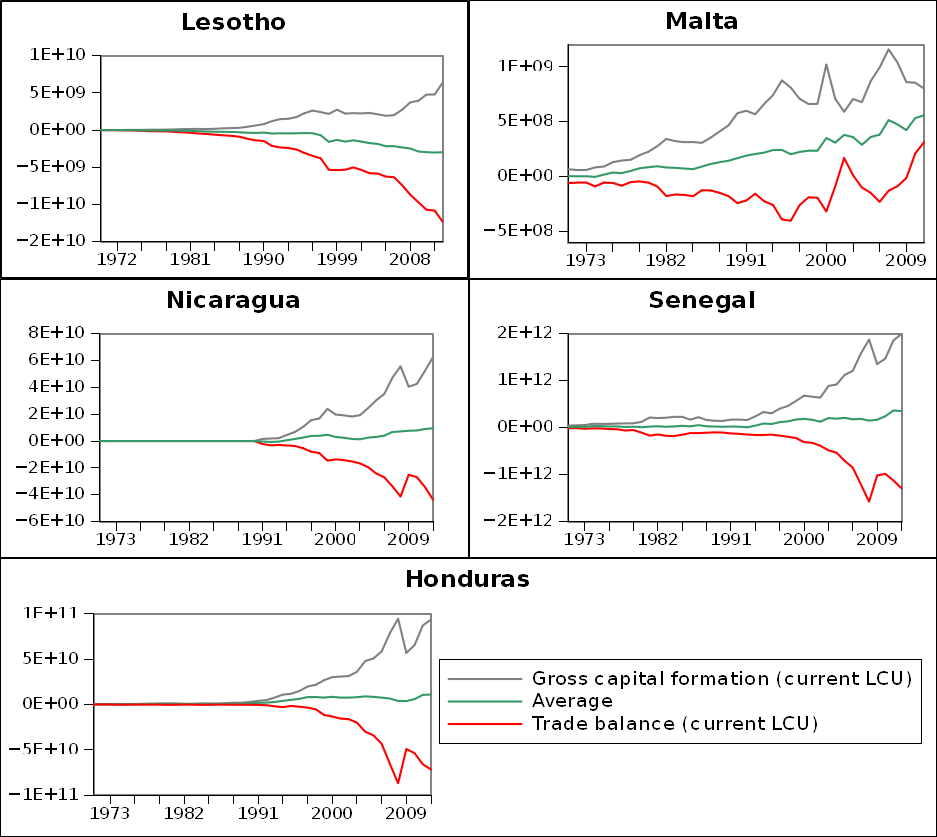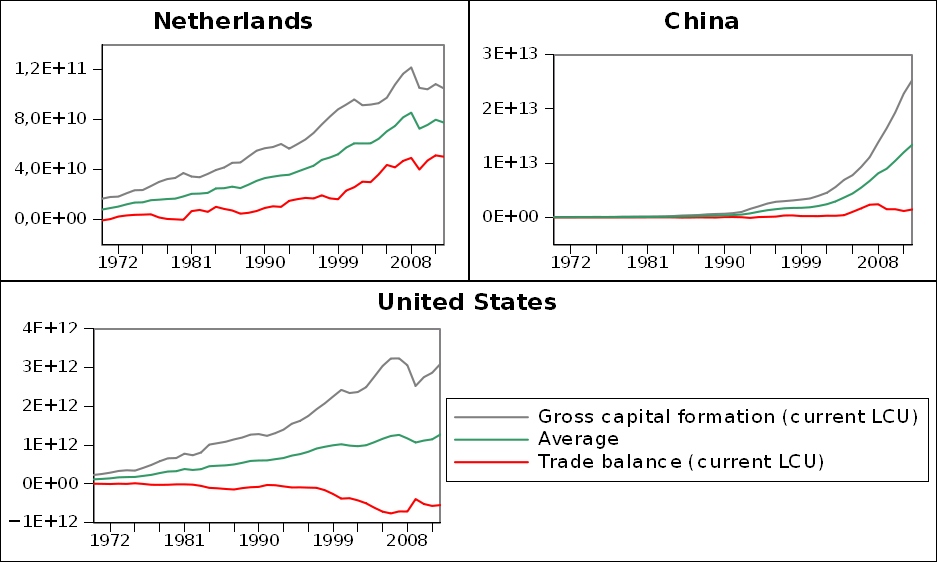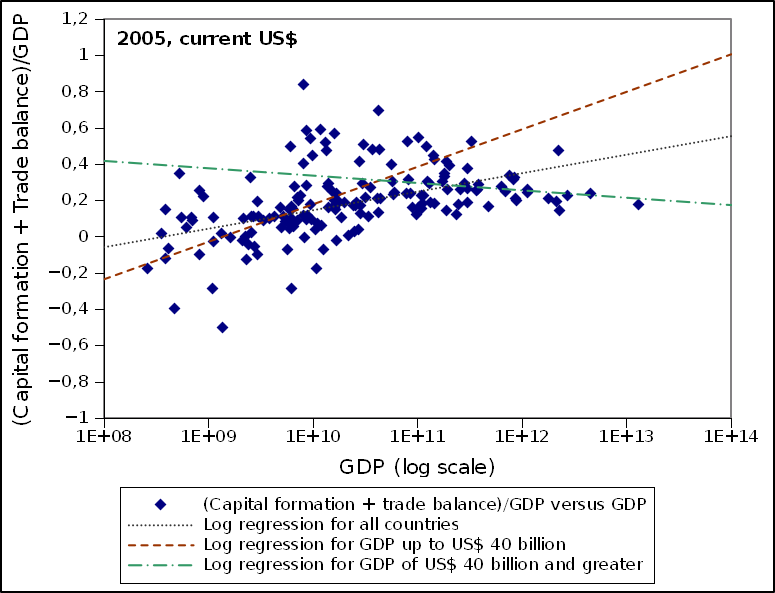Bieda napędzana eksportem
Większość krajów rozwiniętych unika poprawy swojego bilansu handlowego, chociaż propaganda wzrostu PKB głosi czasem coś innego. Powody są poważne.
Gdy gospodarka rośnie, to rośnie także eksport i import. Przykładowo w 2006 roku polski PKB wrósł o ok. 6% rocznie, eksport o ok. 14%, a import o ok. 17% rocznie.

Rys. 1. Wzrost eksportu, importu i PKB Polski.
Opracowanie własne Autora na podstawie danych Banku Światowego.
Nawiasem mówiąc WTO (Światowa Organizacja Handlu) kiedyś stwierdziła dość oczywistą zależność – jeśli produkcja rośnie, to handel rośnie szybciej, a jeśli produkcja spada, to handel spada szybciej. Do tego momentu wszystko wygląda zgodnie z intuicją.
Korzystny deficyt handlowy
Spójrzmy teraz jak zmienia się deficyt handlowy i PKB. Przeważnie gdy deficyt spowalnia albo maleje to spowalnia również wzrost PKB, a gdy deficyt przyśpiesza albo rośnie, to przyśpiesza również wzrost PKB. Innymi słowy poprawa bilansu handlowego jest niekorzystna dla wzrostu PKB, a pogorszenie bilansu handlowego jest korzystne dla wzrostu PKB!

Rys. 2. Zmiany bilansu handlowego i PKB Polski.
Opracowanie własne Autora na podstawie danych Banku Światowego.
Powyższa zależność tłumaczy częściowo dlaczego rządy wielu krajów rozwiniętych prowadzą politykę sprzyjającą utrzymywaniu deficytu handlowego, chociaż ekonomiści rysują różne scenariusze dla wyjaśnienia tego fenomenu. Według jednego ze scenariuszy to świetna koniunktura przyciąga kapitał zagraniczny, który kredytuje zakupy rządowe i prywatne instytucje finansowe, które z kolei kredytują zakupy firm i konsumentów. Wraz z ogólnym ożywieniem gospodarczym rosną także zakupy z importu.

Rys. 3. Bilans handlowy, PKB i inwestycje zagraniczne w Polsce.
Opracowanie własne Autora na podstawie danych Banku Światowego.
Na Rys. 3. sprawdzamy trafność powyższego scenariusza. Rzeczywiście inwestycje zagraniczne zaczynają reagować niemal proporcjonalnie na zmiany koniunktury gospodarczej, ale dopiero wraz z początkiem recesji w krajach rozwiniętych (2001). W okresie po kryzysie azjatyckim (1997) wydają się raczej zwiastować te zmiany, niż reagować na nie. Podobne dwukierunkowe następstwo zmian można stwierdzić w niektórych innych krach rozwiniętych, więc trudno jest jednoznacznie powiedzieć, co jest pierwsze – czy koniunktura gospodarcza, czy inwestycje zagraniczne. Niemniej jednak trafność powyższego scenariusza dla określonych warunków geoekonomicznych jest zdumiewająca!
Nacechowanie PKB
W pierwszych latach transformacji systemowej nie potrafiłem pogodzić się z tym, że zrezygnowano z dochodu narodowego jako miary wyniku ogólnego gospodarki i zastąpiono go produktem krajowym brutto – PKB. Postrzegałem tę zmianę jako przejście z rachunku pożytków dla obywateli na rachunek pożytku dla inwestorów. Potem zauważyłem zachwyty zachodnich komentatorów nad rosnącą siłą naszej waluty oraz prognozy oczekiwanego zwrotu z kapitału tym bardziej entuzjastyczne im lepsze były prognozy wzrostu PKB. Jakoś nie potrafiłem podzielać tego entuzjazmu, mimo że kipiały od niego komentarze naszych polityków i mediów.
Po upływie kolejnych kilku lat, analizując wzrost wielu gospodarek świata zauważyłem, że PKB lepiej koreluje z importem, niż z eksportem. Łatwo to sobie wytłumaczyłem – wszak na imporcie też się zarabia, w dodatku na ogół szybciej, niż na eksporcie. Nie tylko eksport daje wkład do wyniku gospodarki, import także! Dane przedstawione powyżej to potwierdzają. Tymczasem w definicji PKB mamy bilans handlowy, czyli import odejmujemy, a nie dodajemy. Dlaczego? jedyne wytłumaczenie, jakie mi się nasuwa jest spójne z wątpliwościami sprzed lat – bilans handlowy jest podobnie nacechowany entuzjazmem spodziewanych korzyści dla inwestorów. Logicznym następstwem tego jest oficjalna propaganda wzrostu eksportu netto jako składowej wzrostu gospodarki.
Nieporozumienia w sprawie konkurencyjności
Do dzisiaj pokutuje pogląd, że deficyt handlowy świadczy o niskiej konkurencyjności gospodarki. A przecież to nie ma nic do rzeczy – deficyt oznacza, że gospodarka kupiła za więcej, niż sprzedała.
Kiedyś było jeszcze gorzej. Przekonanie o przegrywaniu konkurencji międzynarodowej skłaniało polityków i komentatorów do propozycji mnożenia barier celnych i kwot ilościowych w imporcie albo do subsydiowania eksportu. Bo przecież eksport daje pracę, a import ją odbiera. Sam do niedawna dawałem się złapać na tę populistyczną, lecz częściowo fałszywą argumentację. Pozostałości tego rodzaju polityk trwają do dzisiaj i są często zarzewiem konfliktów, zwłaszcza pomiędzy krajami rozwiniętymi a biednymi krajami rozwijającymi się.
Dzisiaj często mówi się o konkurencyjności danej gospodarki mając na myśli jej zdolność do dostarczania tanich wyrobów i usług. Z tego punktu widzenia gospodarka Bangladeszu byłaby bardziej konkurencyjna, niż gospodarka USA. Oczywisty nonsens takiego wniosku świadczy o błędności omawianej koncepcji konkurencyjności międzynarodowej.
Kosztowny wzrost eksportu netto
Produkcja eksportowa jest jednym z tych przypadków, w których pracownicy otrzymują zapłatę za swoją pracę, ale produkt tej pracy nie trafia na krajowy rynek. Jednak nie musi to prowadzić do nadmiaru pieniędzy na konsumpcję, tzn. pieniędzy nie pokrytych towarami, ponieważ w rosnącej gospodarce ceny produktów są ogółem wyższe o marżę brutto od kosztów produkcji bądź zakupu. Można w uproszczeniu powiedzieć, że zapłata za produkcję eksportową jest ściągana na rynku konsumpcyjnym zasilając część marży brutto ze sprzedanych produktów. Inaczej mówiąc część nadwyżek ze sprzedaży krajowej produktów kompensuje zapłatę za produkcję produktów niekrajowych (eksportowych).
Jeśli eksport rośnie szybko, to na rynek konsumpcyjny trafia coraz więcej pieniądza niepokrytego wzrostem ilości krajowych produktów. Tę nadwyżkę gospodarka może redukować rozmaitymi sposobami, na przykład:
- zwiększać dostawy z importu,
- poprawiać produktywność, co umożliwia spowolnienie wzrostu zatrudnienia przy utrzymaniu trendu wzrostu płac,
- kompensować wzrost eksportu poprzez wzrost zysku przedsiębiorstw z podwyżek cen, co oznacza wygaszanie części nadwyżki przez inflację,
- obniżać płace realne.
Zauważmy, że z wyjątkiem pierwszego sposobu wszystkie pozostałe mogą pociągać za sobą bolesne koszty społeczne. Trzeba także dodać, że redukowanie nadwyżek dochodów z pracy napływających na rynek konsumpcyjny jest konieczne dla zachowania stabilności gospodarki i dokonuje się zarówno dzięki automatycznym mechanizmom rynkowym, jak i dzięki polityce instytucjonalnej tam, gdzie rynek nie jest skuteczny.
W Europie Niemcy stanowią przypadek państwa, które jakiś czas temu przyjęło politykę napędzania wzrostu gospodarczego wzrostem eksportu netto i jednocześnie politykę pełnego zatrudnienia. Ta pierwsza polityka ogranicza możliwości uzupełniania zaopatrzenia rynku dostawami z importu. Ta druga polityka jest zapewne przyczyną, dla której produktywność na tle innych krajów UE nie wygląda dobrze (ogólnie w UE spada). Pozostają zatem dwie dotkliwe społecznie konsekwencje omawianej strategii wzrostu: inflacja bijąca w konsumentów i obniżanie płac realnych bijące w pracowników najemnych.

Rys. 4. Wyniki gospodarcze i społeczne gospodarki niemieckiej.
Dolny wykres – opracowanie własne Autora na podstawie danych Banku Światowego.
Wykresy na Rys.4 pokazują wyniki społeczne gospodarki niemieckiej towarzyszące omawianej polityce. Dolna część rysunku ukazuje zmiany roczne i obejmuje oba okresy silnego wzrostu eksportu netto oraz początek okresu trzeciego. Pierwszy okres to lata 2000-2002. Widoczny jest wzrost inflacji na początku tego okresu. Z literatury wiemy, że w tamtych latach nastąpiło także pierwsze silne obniżenie płac realnych. Więcej danych mamy na temat okresu drugiego, mianowicie lat 2004-2007, gdyż dysponujemy oficjalnymi danymi kwartalnymi. Widać, że inflacja była utrzymywana w ryzach aż do końca 2006 roku, po czym wzrosła do ok. 3% PKB. W tym czasie nastąpiło silnie spowolnienie płac nominalnych i obniżenie płac realnych. To koszt społeczny wzrostu nadwyżki handlowej z ok. 0,5% PKB w roku 2000 do ok. 7% PKB w roku 2007. Na górnym wykresie nietrudno zaobserwować także koszt społeczny omawianej polityki po kryzysie 2009 roku, obciążający niemieckich pracowników i konsumentów od połowy 2011 roku.
Trzeba dodać, że politykę pełnego zatrudnienia w Niemczech sprzyja także redukcja czasu pracy. Podsumowując można powiedzieć – praca dla wszystkich, ale coraz gorzej płatna. Bieda upowszechniana.
Konkurencyjny znaczy droższy
Wróćmy do kwestii pojmowania konkurencyjności. Pogląd o przewadze konkurencyjnej taniochy zyskuje słabe potwierdzenie w odniesieniu do konkurencyjności międzynarodowej. Co prawda są przykłady okresowych sukcesów gospodarek wygrywających wojnę cenową, między innymi dzięki „taniej wykształconej sile roboczej”. Lecz znacznie więcej jest przykładów pokazujących, że okres sprzedawania taniochy to okres kiepskich wyników gospodarczych i fatalnych wyników społecznych.
Praktycy gospodarczy o długoletnim doświadczeniu zwracają uwagę, że współczesna koncepcja konkurencyjności opartej na taniości produktów i taniości pracy jest niepełna, że wymaga uwzględnienia starej miary – Terms od Trade. Indeks Term of Trade jest tym wyższy, im drożej dany kraj sprzedaje swoje produkty i im taniej kupuje produkty tej samej kategorii. Pomiar Terms of Trade jest trudny, gdyż wymaga zliczania różnic cen kategoria po kategorii. Jednak wyniki przekonują, że prawdziwymi wygranymi w walce konkurencyjnej są ci, którzy sprzedają PRODUKTY DROGIE ALE CHĘTNIE KUPOWANE.
Poszczególne kraje rozwinięte oraz tzw. szybko rozwijające się najlepsze swe lata miały wtedy, gdy sprzedawały drogo, a kupowały tanio. Historyczny rekord indeksu Terms od Trade miała Japonia w swych najlepszych latach 1960-tych, zaraz po niej Tajwan przez 15 lat od połowy lat 1880-tych, dalej Singapur w połowie lat 1980-tych, USA tuż przed okresem „trudnych lat 1970-tych”… W ostatnich latach indeks rośnie w „nowych gospodarkach wschodzących” – brazylijskiej, argentyńskiej, południowokoreańskiej, nigeryjskiej… ostatnio także w polskiej.
Można powiedzieć, że konkurencyjność międzynarodowa jest napędzana atrakcyjnymi produktami, a tylko okresowo, w specyficznych warunkach niskimi płacami. W Niemczech Terms of Trade obniża się, zapewne na skutek forsowania pełnego zatrudnienia, co nie sprzyja utrzymaniu wysokiej reputacji producentów i doskonałej marki produktów.
Szansa dla polskiej gospodarki
Bilans handlowy polskiej gospodarki poprawia się. Wraz z dobrymi wynikami w dziedzinie konkurencyjności polskich produktów daje to szansę napędzania wzrostu gospodarki eksportem bez ponoszenia bolesnych kosztów społecznych takiego wzrostu. Trzeba dbać o atrakcyjność eksportowej produkcji, budować reputację producentów i dobrą markę wyrobów i usług, aby eksportować drogo. Niech eksport będzie napędzany w sposób naturalny, czyli poprawą oferty, a nie forsowany naciskiem politycznym czy instytucjonalnym. Jednocześnie trzeba importować taniej, ale także więcej, aby zapłata za „pracę na eksport” znajdowała pokrycie w towarze. Wówczas konsumentom nie zagrozi inflacja, a pracownikom najemnym nie zagrożą cięcia zatrudnienia i płac realnych z powodu wzrostu eksportu netto.
Powyższe jest tym bardziej istotne, że przed polityką gospodarczą stoją inne poważne problemy do rozwiązania, mianowicie dramatycznie niskie płace, bezrobocie, wydłużony czas pracy i zastój w inwestycjach. Ale to tematy na inną okazję.





Najnowsze komentarze